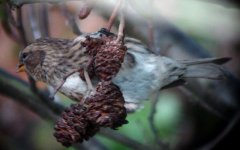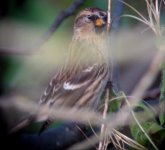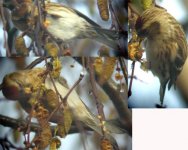Adey Baker
Member
Any comments on the variable amount of streaking on the undertail coverts of Lesser Redpoll (cabaret)?
I've often noted rather limited amounts of streaking on these birds, previously, but recently I've been looking at them more intently and noticed a full range from unstreaked through to heavily streaked.
Is this perhaps age/sex related?
Whatever, most seem to have a very slight buffish wash across the undertail.
Incidentally, yesterday I saw one bird which had a buff wing bar on one wing and a pure white one on the other! This, whatever the angle of the light. Luckily, it was very much a 'brown' Lesser in all other respects.
Adey
I've often noted rather limited amounts of streaking on these birds, previously, but recently I've been looking at them more intently and noticed a full range from unstreaked through to heavily streaked.
Is this perhaps age/sex related?
Whatever, most seem to have a very slight buffish wash across the undertail.
Incidentally, yesterday I saw one bird which had a buff wing bar on one wing and a pure white one on the other! This, whatever the angle of the light. Luckily, it was very much a 'brown' Lesser in all other respects.
Adey







